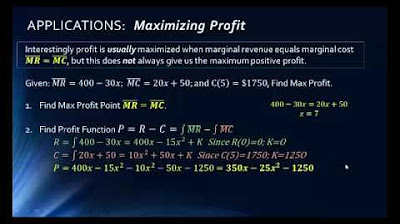Revenue, Profits, and Price: Crash Course Economics #24
TLDRThis economics video explains key microeconomics concepts for entrepreneurs using a pizza business example. It covers implicit costs like opportunity costs, and explicit costs like rent and wages. Businesses aim for zero economic profit in competitive markets. There are also fixed and variable costs of production, and diminishing marginal returns limits specialization benefits. To maximize profit, produce where marginal revenue equals marginal cost. Sunk costs should be ignored when making future decisions.
Takeaways
- 😀 Microeconomics explains concepts to help entrepreneurs make better decisions, like a liberal arts degree provides broad knowledge rather than specific skills.
- 💡 To calculate profit, accountants subtract costs from revenue. But economists also subtract implicit opportunity costs.
- 📈 Companies earn zero economic profit in competitive markets due to competitors entering until all excess profit disappears.
- 😊 Variable costs change with production quantity, while fixed costs remain constant regardless of production volume.
- ⚖️ Average cost per unit falls as production increases due to fixed costs being spread over more units (economies of scale).
- 🔎 Marginal revenue is additional revenue from selling one more unit. Marginal cost is the additional cost of producing one more unit.
- 📉 The law of diminishing marginal returns means that as more resources are added, each additional unit produced provides smaller gains.
- ❌ Sunk costs are expenses already incurred and should not be considered in future decisions.
- 💖 Behavioral economists show that people often make irrational decisions, like staying in poor relationships due to previously invested time.
- 🎓 To maximize profit, produce where marginal revenue equals marginal cost.
Q & A
What is the difference between accounting profit and economic profit?
-Accounting profit is revenue minus explicit costs like ingredients and rent. Economic profit factors in implicit costs like opportunity costs - the income not earned by doing something else.
Why don't companies in competitive markets make excess economic profits?
-If a company starts making excess economic profit, competitors will enter the market, driving prices down and reducing profits to normal levels.
What are variable and fixed costs?
-Variable costs change with output, like ingredients for a pizza shop. Fixed costs stay the same regardless of output, like rent for a building.
Why does average cost tend to fall initially as production increases?
-Fixed costs like equipment can be spread out over more units, lowering the average cost per unit.
What is the law of diminishing marginal returns?
-As you add more of a variable input like workers to a fixed input like capital, the marginal output gained from each additional unit of the variable input eventually declines.
When should a company produce more output?
-A company should produce more output as long as marginal revenue exceeds marginal cost.
What are economies of scale?
-As companies grow bigger, they can utilize techniques like mass production to lower average costs.
What is a sunk cost?
-A sunk cost is a cost already incurred that cannot be recovered.
Should sunk costs be considered when making future decisions?
-No, economists argue that sunk costs are irrelevant to future rational decision making.
What is the role of microeconomics for entrepreneurs?
-Microeconomics helps entrepreneurs understand concepts like costs, revenue, and profit to make better business decisions, even if it doesn't teach specific skills.
Outlines
📺 Introduction to Economics Concepts
Adriene and Jacob introduce basic economics concepts like opportunity cost, accounting vs economic profit, variable vs fixed costs, and diminishing marginal returns. They explain how these ideas help entrepreneurs make better business decisions.
📈 Economies of Scale and Profit Maximization
Adriene discusses economies of scale - how larger companies can produce at lower average costs. She then explains how to maximize profit: produce where marginal revenue equals marginal cost. As production increases, marginal costs also increase due to diminishing returns.
😢 Ignore Sunk Costs When Making Decisions
Jacob and Adriene wrap up by covering sunk costs - costs already incurred that can't be recovered. They stress economists advise ignoring sunk costs when making future decisions, though people don't always follow this logic.
Mindmap
Keywords
💡Microeconomics
💡Opportunity cost
💡Economic profit
💡Normal profit
💡Variable costs
💡Fixed costs
💡Economies of scale
💡Marginal revenue
💡Marginal cost
💡Sunk costs
Highlights
We discussed using deep learning for natural language processing tasks.
The professor explained the transformer architecture for language models.
Attention mechanisms allow models to focus on relevant parts of the input.
Pre-trained language models like BERT achieve state-of-the-art results on many NLP benchmarks.
Fine-tuning is an effective technique to adapt models to new tasks.
Data augmentation can help reduce overfitting when fine-tuning on small datasets.
The professor suggested some interesting applications of NLP like chatbots and summarization.
There are concerns about bias in NLP models which need to be addressed.
More interpretability and transparency are needed for responsible AI.
Multilinguality and cross-lingual transfer learning enable models to generalize across languages.
The professor recommended some state-of-the-art NLP papers to read.
NLP has seen rapid progress recently but there are still many open challenges.
The professor is an engaging speaker and structured the lecture very clearly.
Overall this was a comprehensive overview of deep learning techniques for NLP.
I learned a lot of practical concepts I can apply in my own NLP projects.
Transcripts
Browse More Related Video

Marginal cost & differential calculus | Applications of derivatives | AP Calculus AB | Khan Academy

Math 1325 Lecture 12 4

Marginal Analysis, Roller Coasters, Elasticity, and Van Gogh: Crash Course Economics #18

Marginal Revenue, Average Cost, Profit, Price & Demand Function - Calculus

Marginal cost and average total cost | Microeconomics | Khan Academy

Math 1325 Lecture 9 9 - Applications
5.0 / 5 (0 votes)
Thanks for rating: